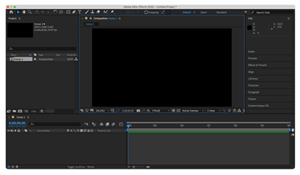AfterEffects

Adobe After Effects CC running on OS X El Capitan
|
|
| Initial release | January 1993 |
|---|---|
| Stable release |
CC 2018 (15.0) / October 19, 2017
|
| Written in | C++ |
| Operating system | Microsoft Windows, macOS |
| Type | Visual effects, Motion graphics, Compositing, Computer animation |
| License | Trialware, software as a service (SaaS) |
| Website | www |
Adobe After Effects is a digital visual effects, motion graphics, and compositing application developed by Adobe Systems and used in the post-production process of film making and television production. Among other things, After Effects can be used for keying, tracking, compositing and animation. It also functions as a very basic non-linear editor, audio editor and media transcoder.
After Effects was originally created by the Company of Science and Art in Providence, Rhode Island, where the first two versions of the software, 1.0 (January 1993) and 1.1, were released by the company. CoSA along with After Effects was then acquired by Aldus corporation in July 1993, which was in turn acquired by Adobe in 1994, and with it PageMaker. Adobe's first new release of After Effects was version 3.0.
The following is the list of versions of After Effects over the years, including the first two versions released by CoSA.
After Effects has extensive plug-in support; a broad range of third party plug-ins are available. A variety of plug-in styles exist, such as particle systems for realistic effects for rain, snow, fire, etc.
With or without third-party plug-ins, After Effects can render 3D effects. Some of these 3D plug-ins use basic 2D layers from After Effects.
In addition to 3D effects, there are plug-ins for making video look like film or cartoons; simulating fire, smoke, or water; particle systems; slow motion; creating animated charts, graphs, and other data visualization; calculating the 3D movement of a camera in a 2D video shot; eliminating flicker, noise, or rigging lines; translating timelines from FCP or Avid; adding high-end color correction; and other workflow improvements and visual effects.
...
Wikipedia
